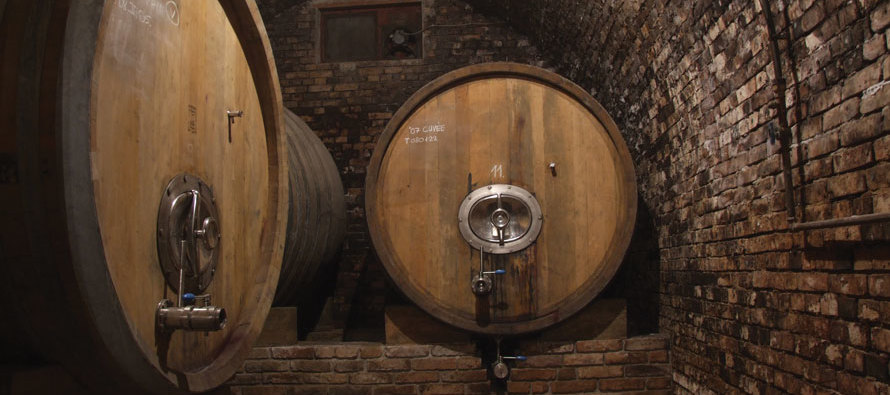Oak Aging and its Effect on Wine

Aging a wine in oak barrels can complement and contribute to the character of a wine. Oak enriches a wine and makes it smoother, richer, and sweeter. If used judiciously, it adds to the complexity of wine and imparts a round, soft, viscous feeling on the palate.
New oak barrels impart the strongest flavor to wine. With reuse, the wine extracts progressively less oak flavor, and after about five seasons of usage, the barrel is practically depleted of its oaky, flavorful extract. Wine aged in small oak barrels has a greater surface contact to the wood than those aged in larger ones and therefore leaches out more oak flavors (and tannins).
Another reason for aging wine in wood is that it allows the wine to receive small quantities of air, which produces a slow, controlled oxidation. This helps in the evolution of the wines and enhances its ultimate quality.
The toasty character found in many oak-aged wines is due to aging them in charred oak barrels. This so-called “toasty oak” is very easy to identify once you have the descriptive term in mind. Oak has a soft, round, rich, woodsy smell, and the toasty character is similar to the smell of toasted bread. Toasty oak flavor is fairly common in Chardonnay wines.
You wouldn’t think that the way the barrel is made would have any effect on the wine that it contains. However, the construction of the barrel is an important and often overlooked item. There are several types of oak, and there are different techniques employed to make barrels. Barrels built using the classic French coopering process are most suitable for aging wine. Air-dried, hand-split staves are better than kiln-dried and sawed, and slow toasting of the oak staves over a small fire is superior to steaming the wood. Many wineries have come to realize the importance of barrel construction, and oversee the coopering process themselves.
The type of oak is also an important part of the equation. The slower-growing oaks impart a finer and subtler oak flavor to the wine, and are considered superior. American oak imparts the strongest oaky scent. Limousin oak (French) is less strong, but still imparts a strong oaky flavor that can dominate the character of the wine. Wine makers are cautious using either of these types of oak for fear that they will overpower the more delicate flavors in the wine, thereby decreasing the degree of complexity. Nevertheless, the more flavorful oaks do have their place.
Many wineries use American oak barrels when aging Sauvignon Blanc in order to help mitigate the strong, racy, green character of the varietal. Other wineries age their Cabernet Sauvignons in American oak, but these are usually age-seasoned barrels that have already lost a portion of their oak scent. Beaulieu had a long history of aging their Cabernets in seasoned American oak.
The use of Limousin oak in California Chardonnays has many proponents, but others favor the use of the more restrained, tighter-grained oaks.
The tighter-grained French oaks impart a more muted oak character to wine. This type of wood is the most popular type in use, being especially suited to both Chardonnay and Cabernet. There are several different varieties that are derived from specific geographic regions: Nevers, Alliers, Vosges, and Tronçais. Each of these imparts subtle but distinctly different nuances to the flavor of the wine.
Excessive oak flavor in a wine is a taste distraction. A well-made wine will have just enough oak to give it added complexity without subduing other subtle flavor elements. Too much oak will snuff out the more delicate scents and flavors, and actually make the wine less complex. Excessive oak gives the wine a big, ponderous, clumsy feel. Such wines lack refinement, sophistication, and charm. More than a hint of oak flavor is too much.
Of course, there is the school that supports the belief that oak has no place in the vinification of wine. They argue that wine should derive its flavors from grapes, not trees. To some extent, I feel they are correct. If oak is dominating the wine, you do taste trees. But a little dab of oak is very complementary to many wine styles. Think of it this way: the slight touches of make-up that women use can have a dramatic effect on their appearance; however, when the same make-up is piled on in excess, the results are disastrous.
The excessive use of oak is more common in white wines. Over-oaked wines develop a strong vanilla-like sweetness, and they become so top-heavy and rich that they border on cloying. Never use this style wine with light, delicate dishes, as the wine will assuredly overpower and subdue the food’s delicate flavors. What’s more, matching such wines to full-bodied dishes makes the combination excessively heavy and ponderously cloying.
When matching white wine with food, use wines such as New Zealand Sauvignon Blanc, Pouilly Fumé, or Chablis. These wines never see oak. Although unoaked Chardonnay and Sauvignon Blanc are available from many wineries worldwide, they are often not labeled as such.

John Fischer
Dr. John Fischer is a member and two-time president of the Omaha Branch of the International Wine & Food Society, past director of the Nebraska chapter of LADV, and the founding member of the Council Bluffs Branch of the International Wine & Food Society. He teaches a course on matching wine with food at the Institute for the Culinary Arts in Omaha and is the author of the books, “The Evaluation of Wine – A Comprehensive Guide to the Art of Wine Tasting” and “Wine and Food – 101.”
No comments
Write a commentOnly registered users can comment.











